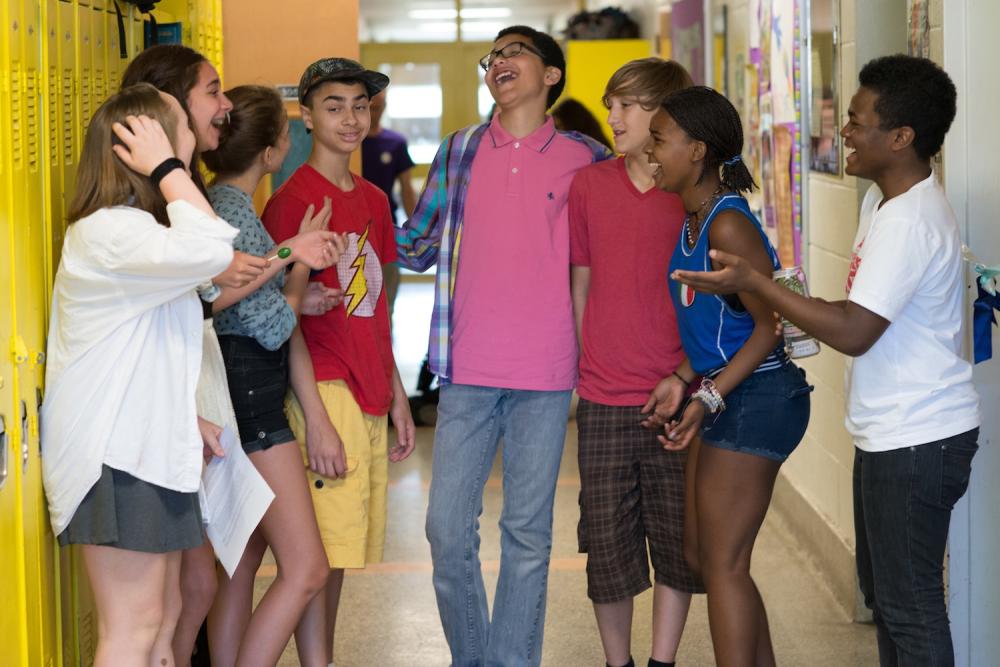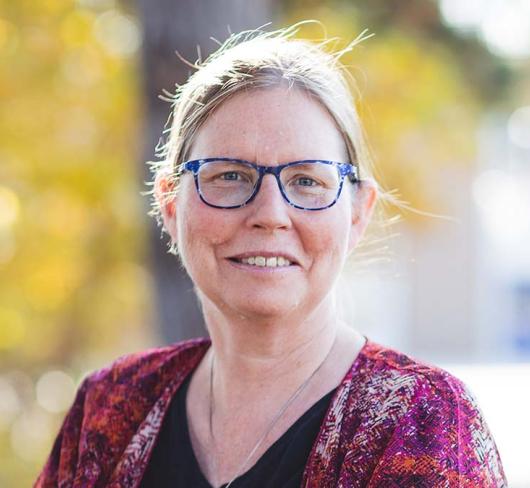
It's the Small Things that Matter Most
On June 14 2013, City View Alternative Senior School in Toronto's West End became the first grade 7 and 8 school in North America to proactively establish a multi stall all-gender washroom. This is the story of our six month journey
Early Rumblings
There is a student mailbox in my classroom. It’s locked, oddly shaped and multi-coloured, and it has an opening where anyone can drop in a note. Sometimes I get a letter of appreciation, other times a call for help. And on the last day of school in June of this year there was a tiny purple strip of unsigned paper that simply read “Sometimes it’s the small things that matter the most.” Perhaps coincidentally, we had just celebrated the opening of an all-gender multi-stall washroom, the culmination of a six-month journey that began in December of 2012.
I work at City View Alternative Senior School in Toronto’s west end, a grade 7 and 8 school where the provincial curriculum is taught through the lens of social justice. Race, class, gender, sexuality, ability, power, and oppression are all integrated as the content material in many of the classes, along with an emphasis on activism and the need to do something to change the world rather than simply discuss it.
So it’s probably not surprising that one or more of our students began mucking with the signs on our washroom doors. A sketch of a pair of pants was taped on top of the skirt. A slip of paper that read “Not all girls wear dresses” appeared. And on the boys’ door: “Some boys wear skirts.”
We had been discussing the difference between sex and gender in some of our health classes through the fall term. In a written reflection, grade 8 student Celeste wrote: “I used to think that they were the same thing, but I quickly learned that they are two very different things.” And Misha commented, “I have always known that sex is what you are physically and gender is what you feel you are on the inside, but I always thought that there were just two or three ‘set in stone’ sexes and genders – I learned that there is a large spectrum, and different people can fall anywhere on that spectrum.”
The idea that gender is a social construct, that it’s society’s arbitrary “rule book” for what your body means, is not beyond the average 12-year-old. But people of all ages do need ample time to discuss and differentiate between sex, gender, and sexuality. One resource that was helpful for our students was The Genderbread Person (itspronouncedme- trosexual.com/2012/03/the-genderbread- person-v2-0/), a model by Sam Killermann that leads people away from a binary either/or notion of sex, gender, and sexuality, and presents a more complex series of continuums.
Legal Precedents
We also began looking at Bill 33 and Bill 13, known as Toby’s Act and the Accepting SchoolsAct respectively. Both pieces of legislation passed in 2012, altering the political landscape in significant ways. Toby’s Act formally places gender identity and gender expression into the Ontario Human Rights Code. And the Accepting Schools Act, while broad in scope around issues of bullying, explicitly mentions the LGBTTIQ community (Lesbian, Gay, Bisexual, Transgender, Transsexual, Intersex, Questioning), and the need to create a positive school climate in order to prevent gender-based violence, homophobia, transphobia, and biphobia.
In my mind, the most important aspect of the Accepting Schools Act is that it legally mandates educators to take steps proactively to modify the school space to be inclusive, rather than wait and react to human rights complaints from students or staff. In essence, it removes the onus from students to self-identify, a crucial element with respect to the safety of marginalized groups.
The Politics of Language
I began wearing a bright pink button that read “All-gender washrooms: think differently,” which inevitably sparked a conversation wherever I went. At a party during the winter, the button landed me in the middle of an important discussion. “Why not just slap a sign on the door that says Washroom and be done with it?” said someone, innocently enough. But this misses the point. The language used to describe the space is important in highlighting its political significance .
Although the current trend is to use the term gender-neutral washroom, I’d like to make a case against it. Neutral is a tricky word, in that it communicates different things to different people, but usually calls to mind a position between extremes – a dispassionate, objective place where nobody is taking sides. But an all-gender washroom is absolutely about taking a side, one that passionately affirms the right of all students to be in a school environment that celebrates them as individuals. This is not about creating a washroom for trans students: it is about creating a washroom for all students. And so my vote is for the term all-gender.
A word of caution
Here is another danger. Individual schools choose the path of least resistance and create a single-stall, accommodated washroom. Typically it is the washroom already used by staff or students with disabilities. And quite possibly, students who are gender non-conforming or who identify as trans will not use them.
This is not rocket science: students who are required to “out” themselves every time they need to go to the washroom face the same targeting that the accommodated space attempts to address. It shines a spotlight on “that kid” and in a culture where homophobia and transphobia are (let’s be honest) endemic, regularly outing yourself simply isn’t safe.
The idea of all-gender multi-stall washrooms is far more radical. When all students have access to this space and use it regularly, it suddenly becomes impossible to know where any particular individual falls on the gender spectrum. The entire school community is now invited to take responsibility for challenging its assumptions about other people and for thinking about what it means to be a “boy” or a “girl.”
The Parent information Session
The smell of gingerbread fills the school hallway. Students have baked gingerbread people to give out to parents along with the Genderbread handout. They have put up posters from the Gender-Based Violence Prevention Office of the Toronto District School Board, made about 400 buttons with various slogans related to the washroom, and put out materials about Toby’s Act and the Accepting Schools Act. Three students, Plum, Dia and Jade, have somehow even managed in one hour to write a song with guitar accompaniment to open the event. As the final chorus rings out – “We finally did it/It’s equal now for everyone/’Cuz separated washrooms are not fun” – Tatyanna, a grade 7 student, takes the floor to emcee the event. She seamlessly facilitates the evening, introducing guests from the Gender-Based Violence Prevention Office, our superintendent and principal, all the while keeping a steady focus on the student activists in the room who speak eloquently about the need for the all-gender washroom.
There are questions from parents about acts of violence in the washroom, and students and staff alike are able to articulate that there are very clear policies to deal with violence no matter where it happens. They also point out that schools that do not have all-gender washrooms cause a type of violence, by creating enough fear that some students refuse to use the washrooms at all and can end up with urinary tract infections.
Most of all, the confidence of students and staff communicates the groundwork that we have done as a community throughout the past six months.
The Ribbon Cutting
The day of the opening of the washroom arrives. We assemble the entire City View community and listen to music, spoken word, and speeches from students and special guests. Cheri DiNovo, the MPP for Parkdale– High Park who was instrumental in passing Toby’s Act is on hand to congratulate the students. In true City View form, no fewer than 20 grade 7 and 8 students have asked to simultaneously cut the ribbon that hangs across the doorway, and somehow with ten pairs of scissors, we manage it. Inside, there are two stalls – the former all-girls wash- room that (without a cent of money required from the board) is now available for anyone to use. (On our floor there are now three washrooms: an all-girls, an all-boys and an all-gender.)
In our debriefing, students made recommendations for other schools: have patience, make sure to get student input, build a community that trusts each other, involve the parents, really know what you’re talking about so that you can address concerns, and listen carefully to the deeply personal stories that some people will share. Most of all, Dia writes, “You should fight for it, because it will help students and inspire other schools to do it too.”
In the weeks that follow, there is a steady flow of grade 7s and 8s into the all-gender washroom. It’s without embarrassment or nervous laughter. It just is. The euphoria of the ribbon-cutting event is now ancient history, and the grade 7s have been passed the torch to educate next year’s incoming students about the all-gender washroom.
Julian in grade 8 writes, “It is a revolutionary space.” Although all we did was put a sign on a door, I couldn’t agree more. Perhaps that student who wrote to me on that tiny strip of purple paper got it exactly right. It is the small things that matter the most.
Resources:
Supporting Transgender and Transsexual Students in K-12 Schools: A Guide for Educators (Toronto: canadian Teachers’ federation, 2012).
Questions and Answers: Gender Identity in Schools (Ottawa: public health agency of canada, 2010).
RainbowhealthOntario.ca
A fuller list of resources accompanies this article online at etfovoice.ca.
